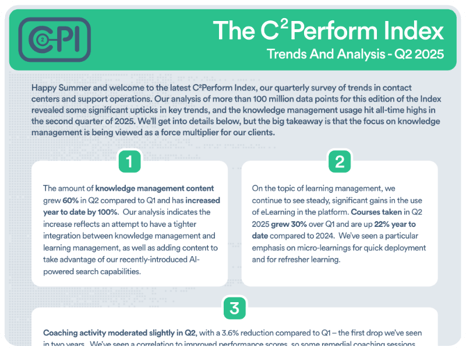Quality assurance (QA) is a critical part of any contact center’s performance management and improvement initiative. Effective contact center QA helps identify what is or isn’t working so course corrections can be made as needed.
However, setting up strong QA processes can often prove easier said than done—even for a large and well-funded contact center. Let’s go over what quality assurance is for contact centers, how to set up some strong quality controls for your QA processes, and what to look for in your QA tools.
What Is Quality Assurance for Contact Centers?
In contact centers, quality assurance is the term for all of the processes and tools used to ensure that the organization’s quality standards and requirements are met. This is sometimes conflated with quality control (QC), but the two terms are distinct from one another.
QC is primarily concerned with checking that quality assurance guidelines are met. Quality control is part of QA, but it’s not truly interchangeable with QA. It’s kind of like the difference between a hand and a person. A hand is part of a person and a critical part of how a person interacts with the world, but the hand on its own isn’t a person (outside of the Addams Family, that is).
Quality assurance is an important part of business operations because it helps to create and enforce accountability for everyone in the organization. This, in turn, helps to motivate employees to perform at their best and uphold the reputation of the business.
Strong quality assurance and controls also help to improve customer satisfaction as they receive high-quality service from your organization. This can help to encourage repeat business and even word-of-mouth advertising. For example, Annex Cloud states that “92% of customers trust recommendations from friends and family; a happy customer will positively influence their network.”
How to Set Up Quality Assurance for Contact Centers
Whether you’re looking to establish a new quality system for your organization or are modifying an existing one, it’s important to review the basics about QA setup for business processes. Here are a few simple tips for setting up or modifying a quality management system for your organization:
1. Evaluate Your Current QA Process and Identify What to Keep or Change
Before you modify your whole QA process, it’s important to take stock of its current state and assess what is or isn’t working. Are there any gaps in the quality assurance workflow that need addressing? Potential gaps that could result in important issues being missed (or minor issues being over-weighted in assessments)?
Take a careful look at your QA process and decide which elements you want to retain and which ones need to be eliminated or revised. This may mean taking some time to set up QA metrics if you haven’t already.
2. Think about Who Will Read Your QA Reports
Who is going to “consume” the information that comes out of your QA process? Employees, managers, senior management, the QA team, training personnel, and other key stakeholders will often have different priorities for QA reports.
So, your QA process output needs to take into account the needs of each audience. This way, your QA can provide a more valuable experience across the whole of your organization. Take some time to consider what you’re going to do with QA and how it can influence your team.
3. Select Appropriate Quality Assurance Metrics
It's important to note that quality assurance may mean different things to different people. So, QA metrics will need to change depending on your specific business workflows.
For example, consider the difference between a call center and a manufacturing plant. In contact and customer support centers, quality assurance is being applied not to a physical product like it would be for a manufacturing plant. So, the specific performance metrics measured would be different.
In a contact center, quality assurance metrics measured might include things like time-to-resolution, call resolution rate, and number of customers serviced per hour. A manufacturer might have QA metrics more related to parts tolerances, rejection rates, and part throughput to meet client production requirements.
4. Use a Goal-Setting Framework for QA Goals
It can help to follow a goal setting framework such as the SMART framework. Under SMART, you would set goals (and pick appropriate metrics to match) that are:
- Specific. The goal should clearly define what needs to be accomplished and who is responsible for meeting that expectation
- Measurable. The goal needs to use an objectively measurable metric to determine success or track progress.
- Achievable. Goals need to be realistic for your team to accomplish. This may require an examination of past performance data to determine what is or isn’t feasible on a per-employee basis.
- Relevant. Each goal set should align with your overall business objectives and strategy and serve a clear purpose.
- Time Bound. There should be a defined period of time for every goal so people know when they should expect to produce results. Time limits should be near enough to motivate employees while remaining realistic for the goals being set.
So, what would an example of a good or bad goal for a QA process be under this framework? Let’s take a look at two hypothetical goals and examine each for compatibility with SMART:
- Have a positive, upbeat attitude.
- Call center employees must close 10 support tickets per shift.
The first goal might sound like a good goal for QA. After all, positive interactions are a key part of driving customer satisfaction. However, it’s more of a mission statement than a legitimate goal. The goal doesn’t define who should have a “positive, upbeat attitude” or when they should exhibit the behavior. Additionally, it’s impossible to objectively quantify positivity in a reliable way and it only vaguely supports the business’ overall goals.
Goal 2 does a much better job of meeting SMART criteria. It defines a specific task (closing deals) for specific employees (call center employees). It is relevant to driving the business’ overall goal of providing support to customers. And, it defines the time period for achieving the goal.
However, the question of achievability would depend on the average length of time it takes to process a support ticket. If the average ticket time is less than 40 minutes, this would be an aggressive but achievable goal since that would allow the resolution of up to 12 tickets in an 8-hour shift. If it takes an average of one hour to resolve a support ticket, then this goal would not be achievable.
So, it’s important to consider the realities of your business processes when setting goals.
5. Document Your Processes and Evaluations
After setting goals and choosing QA metrics, it’s important to create a formal document for your quality assurance processes that you can use to consistently apply QA principles to your contact center. Having a formal document helps with the enforcement of QA requirements since it creates a single resource that everyone can see to know what’s expected of them.
It can also help to establish a consistent method of delivering QA documentation to employees. For example, you could send an email with the QA document in an email, share a link to a Google Drive folder with the QA document in it, or use your team communication/collaboration tools to distribute it.
It can also help to keep an archive of previous evaluation data. How? One way is by providing a document of who your consistent top performers are and who needs the most help. This makes it easier to recognize top-performing employees and reward them.
6. Avoid Creating Double Standards
When creating a QA process, consistency is key. Rules should apply equally to all employees—even those in senior roles or in leadership positions. Having a double-standard where team members follow the rules while leadership does not is a sure way to, as the Illinois CPA Society puts it, breed “disloyalty, lack of motivation and, ultimately, failure.”
For any QA metric that can be applied to management as well as team members, management should strive to meet those metrics as enthusiastically as their teams are expected to. Team members take their cues from their leaders, so this is crucial for encouraging compliance with QA standards.
7. Identify Useful Tools for Enacting Quality Assurance (Use Technology)
Having the right QA goals, processes, and metrics is a good start. However, you also need the right tools to monitor metrics and enact QA processes. So, it’s important to look for tools that can help you make your quality assurance strategy a reality.
Technology tools can greatly simplify the task of recording and keeping track of the quality of employee work. However, not all technology tools are created equally. Some tools might do one thing amazingly well, but not do anything else well enough to suit your needs.
In short, it’s necessary to identify the right tools to add to your QA process.
What to Look for in a Quality Assurance Tool for Your Business
There are many resources out there that can help you with your quality assurance processes. One thing to look for in a quality assurance tool is comprehensiveness. Does the tool put everything you need for your QA plan in one place? Does it collect performance data, communications, coaching, and more into a single resource?
A comprehensive tool simplifies your QA management since it means less switching between different tools to assemble your data and manage quality processes. It allows you to save time and frustration dealing with APIs for unrelated systems and talking to different vendors trying to figure out why some random element of your toolkit isn’t working.
Are you ready to transform your quality assurance process with a complete suite of QA resources and associated employee performance management and engagement systems? Reach out to C2Perform now to get started!
 English
English Español
Español





.png?height=350&name=Untitled%20(300%20x%20175%20px).png)



